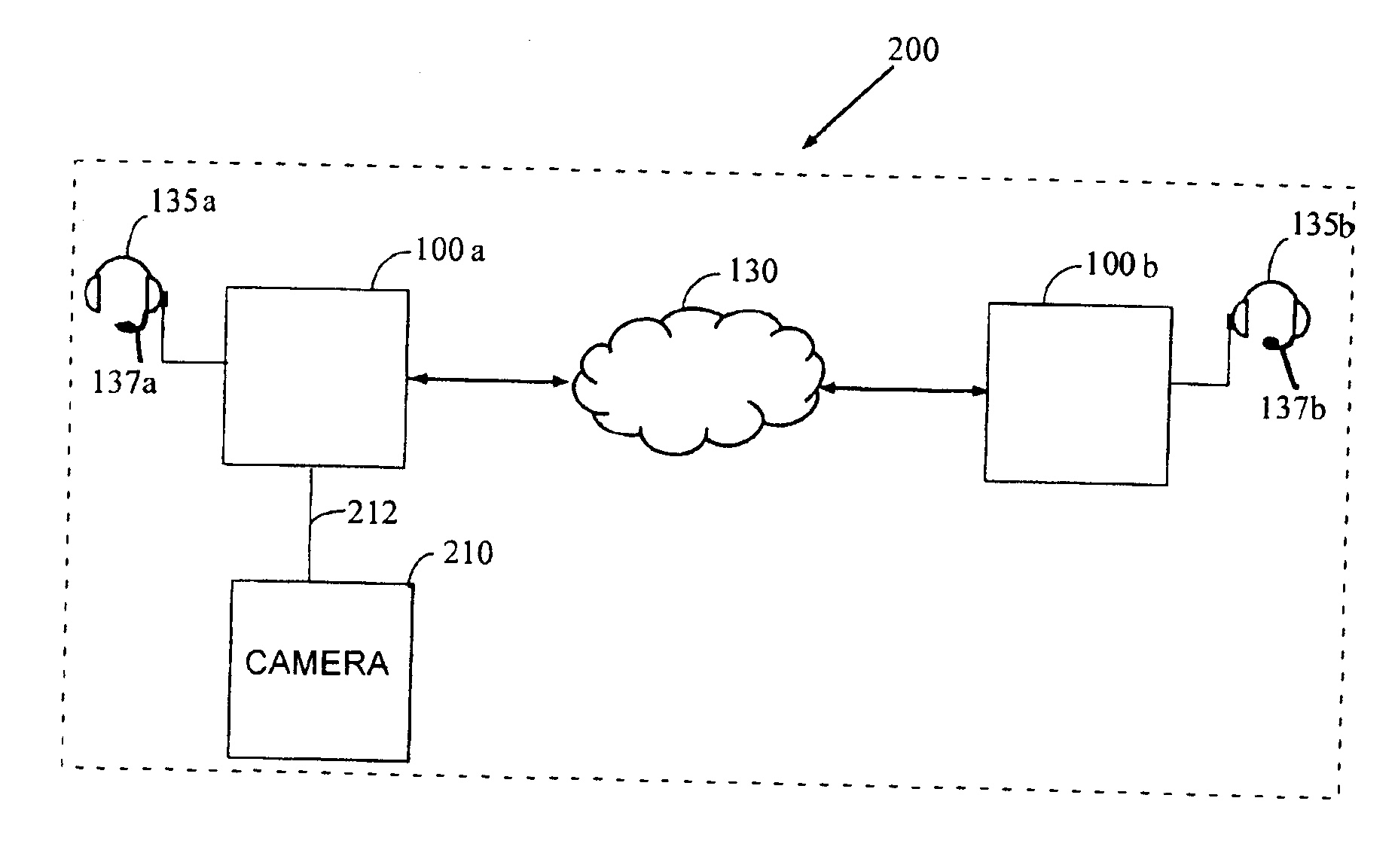[0015]The wireless audio
system of the present disclosure uses the 802.11 protocols or Wi-Fi as a
transmission medium. Both
microphone transmission and IFB functions will be digitized in order to be transmitted. Ideally a 24 bit ADC and DAC would be used which would raise the quality beyond what is currently available with VHF systems. This
system would also allow for stereo both directions if required and which is not available in existing art systems. The use of Wi-Fi in the inventive wireless audio system would allow dozens of mics and IFBs with only one Wi-Fi
receiver at the mixing board. This common
transceiver could be based in a
laptop computer which would be the mixing board as well as serve other functions such as a teleprompter controller. The inventive wireless audio system would have both
microphone transmitter and IFB
receiver in one device so there needs to be only one battery. Because the inventive wireless audio system uses Wi-Fi the
transmitter would use less power than many existing art designs and would have a long battery life. The inventive wireless audio system would be digital so battery levels could be transmitted back to the mixing board operator and the mixing board operator could control the mics
gain remotely both using the same wireless channel as the audio programs. The inventive wireless audio system based on a Wi-Fi
transceiver would also be much less expensive to manufacture and maintain than existing art systems.
[0016]The inventive
wireless microphone / IFB would also have several other useful features, one being a simple and easy to use synch function. Where several groups of wireless microphones would be stored in a common area they would be subject to being mixed and mistaken for each other. The inventive
wireless microphone / IFB should have a button that is pressed at the same time as a button on an adjacent unit they will automatically find each other and
sync to each other at the IP level and forsake previous
sync partners. Any time they are turned on and operational they immediately search for their mate and connect. An additional enhancement to the inventive wireless
microphone / IFB would be for it to have a display that could show functions and information such as received
signal strength, volume level,
MAC address, battery level, earphone level, connection status, to mention a few.
[0017]Another aspect of the IP based microphone of the present disclosure is an IP based hardwired microphone interface. It would ideally be powered by “
power over Ethernet” (POE) and the interface in turn would power a standard existing art analog microphone using a standard analog microphone connector. It would use the same
sync feature as the inventive wireless microphone mentioned above, but rather than connecting wirelessly, it would connect by searching the
router that it was connected to, looking for its synced
receiver. Ideally it would also have a display that would show connection status and its
MAC address to aid in debugging and organizing especially when used simultaneously with many other similar interfaces.
[0018]The speed at which the inventive microphones will be widely adopted will be slower if there isn't sufficient support equipment of a similar technology or a way to adapt between the new inventive technologies and older and well established technologies during a
crossover period. There is a great deal of high quality and expensive equipment that is instantly antiquated by the inventive devices presented here even though this equipment may have been recently purchased and consequently some users may have a problem in abandoning the equipment in the short term. An additional inventive
data adapter would somewhat solve this problem by creating a bridge, enabling existing ADAT based hardware to work with IP based microphones, also an inventive
MIDI to IP adapter would allow similar results for
MIDI devices. These two inventive devices coupled with existing digital mixers would allow a near complete digital solution from microphone to broadcast and allow little or no place for
noise to develop or enter the audio channel even when captured half way around the world.
[0020]This type of inventive mixer would also allow mixing to be accomplished in maximum digital fidelity off-site. That is to say a sound mixing engineer could be actually working in Australia while the recording artists would be performing in a
studio in North America. In the case of live events where signal latency is an issue, the sound mixing engineer in Australia could be operating a mixing board remotely and yet be listening to a maximum fidelity feed, though slightly delayed by propagation delays but the mixing adjustments would be occurring on his mixing board that is linked to the actual mixing board located at the live event and is the one working directly and in real time with the live input signals. This would be especially useful for television networks when they are covering sporting events in far flung cities as they could use a headquarters based in-house engineer for consistency rather than hiring locally at the venue where that operator might not perform in a way that the network usually does. There would also be huge travel and lodging savings involved in using such an inventive set of devices in this way.
 Login to View More
Login to View More  Login to View More
Login to View More 


